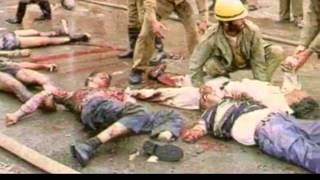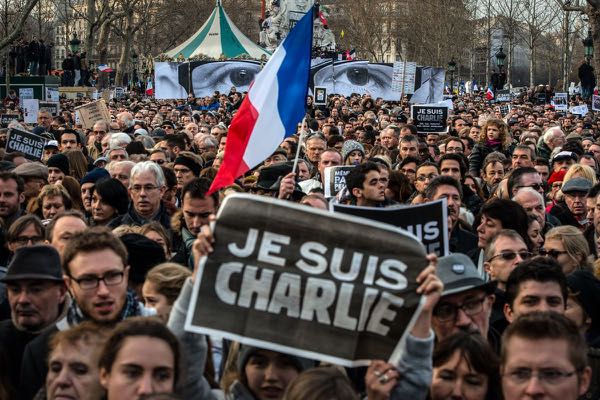Mass Shootings Follow the Gladio “Strategy of Tension”
henrymakow.com

The strategy of tension is a method of social control involving a series of covert attacks upon a population, intended to promote stress and fear amongst them. The purpose is, by inducing a mistrust of one another and of the world at large, to increase child-like dependence upon perceived authority figures (such as national governments). The English phrase originates from the Italian (strategia della tensione), which was first applied to Operation Gladio in Italy.
“When you were on the Right you were not supposed to attack the State or its representatives. You were supposed to attack civilians, women, children, innocent people from outside the political arena. For one simple reason: To force the Italian public to turn to the State turn to the regime and ask for greater security. This was precisely the role of the right in Italy. It placed itself at the service of the State which created a strategy aptly called the “Strategy of Tension” in so far as they had to get ordinary people to accept that at any moment over a period of 30 years, from 1960 to the mid eighties a State of emergency could be declared. So, people would willingly trade part of their freedom for the security of being able to walk the streets, go on trains or enter a bank. This is the political logic behind all the bombings. They remain unpunished because the state cannot condemn itself.”
Methods
The methods used are most obviously illegal and violent i.e. assassinations, kidnapping, paramilitary operations but also include propaganda, economic sanctions, support of civil unrest, fake grassroots movements, promotion of disruptive memes or technologies and the escalation of formerly peaceful protests by use of agents provocateurs. These are typically carried out under a false flag and combined with disinformation and use of enemy images to demonize uninvolved third party. If state agencies engage in staging or promoting acts of terrorism the term “state terrorism” is used, e.g. by former German chancellor Helmut Schmidt.[2]
Deniability
The strategy of tension operations are potentially disastrous if uncovered, so require a high level of secrecy to afford their perpetrators plausible deniability. To be effective, they must be sustained, and they are therefore the preserve of intelligence agencies, the military or national governments. Organizations used are infiltrated and controlled but not directly affiliated with their controllers (e.g. Propaganda Due, Ordine Nuovo, ISIS, …). Nevertheless, some government-backed strategies of tension have been uncovered since WW2.
The PsyOp component of a strategy of tension
The main target of a strategy of tension is the public opinion, to manipulate votes, created a casus belli to legitimate a war, to call for a strong leader or roll out mass surveillance and denounce peacemakers as ‘unpatriotic’. False flag terrorist attacks are just the tip of the iceberg of possible measures to achieve these goals.
In “Interdoc and West European Psychological Warfare“, Giles Scott-Smith puts the strategy of tension in a broader context.
“Ultimately, Interdoc‘s value comes from it being a remarkable example of the way European security services sought to engage with and manipulate the public sphere, initially out of serious concerns for the effects of peaceful coexistence on Western ideological solidity, and eventually as a means to secure a strategic advantage in the Cold War.”
Giles Scott-Smith (2011) – [3]
“Peaceful coexistence” refers to the Russian policy after Stalin, meaning the absence of a Soviet threat.
Based on official statements he shows that prolonged periods of peace are seen as a threat to Western power structures, the established order and political ‘stability’ by the establishment. The proposed ‘solution’ to this is – in the propagandists phrasing – to “raise awareness” of external threats or to “encourage a responsible citizenry as part of the process of maintaining a democratic society”. The result may be called fine-tuning of democracy and included staged terror attacks under a false flag in the past.

The same rhetoric is put forward by the Joint Statement of European Ministers of the Interior after the Charlie Hebdo terrorist attack:
“In order to tackle the root causes of radicalization (“Radicalization” refers to a value shift towards fovouring a more equal distribution of wealth) in particular of young people, the EU should consider strengthening targeted actions designed to raise awareness and promote the respect of fundamental rights and values”.”
European Ministers of the Interior (2015) – [4]
“Ultimately, Interdoc‘s value comes from it being a remarkable example of the way European security services sought to engage with and manipulate the public sphere, initially out of serious concerns for the effects of peaceful coexistence on Western ideological solidity, and eventually as a means to secure a strategic advantage in the Cold War.”
Giles Scott-Smith (2011) – [3]
The extraordinary need for attachment and protection in the face of danger may explain why there is so little public outcry when false flags are made public. The ambivalence and confusion when protective figures are simultainously a source of terror
“lead to hyperarousal states for which the memory can be state-dependent or dissociated, and this memory only returns fully during renewed terror. This interferes with good judgment about these relationships.” Bessel v.d. Kolk [5]
Thus the idea that parts of a democratic state may be involved in acts of state terrorism may be split off and denied as a psychological defense of basic beliefs.
Implementation
Recognizable patterns include, but are not limited to:
-
- An official narrative is quickly agreed upon and blames either “Lone nuts” or the enemy du jour
- “Lone nuts” that die shortly after the event and/or have no chance to explain their side of the story
- The number of reported perpetrators, decreases as the official narrative unfolds
- Evidence which is quickly destroyed and/or made inaccessible to public or to journalists because of “national security“
- Obviously pre-fabricated statements: responses are made which are far too quick – exploiting the targets’ moment of psychological shock
- Politicians and commercially-controlled media: blaming designated culprit before any investigation, hate speech, revenge, threating war or sanctions, fostering police state legislation
- Name changes or misspelling of suspected lone nuts and/or intelligence links emerge
- Imagery of low quality emerges, with mismatching details in different versions or viewing angels, time stamps and origin obscured
- Presented evidence and history of Lone nuts contains bold archetypes, letters, testaments, even passports
- Eye witness accounts are incompatible with press reports
-
- Lost and Found ID leads a direct trail to allow the official narrative‘s perpetrators to be identified
- Any ideas apart from this are termed “conspiracy theories” and dismissed by the establishment
- The commercially-controlled media is resentful of any serious criticism of its own early reporting, citing mostly sources from government, so called experts, the police or news agencies, i.e. Reuters, AP.
- Official investigation avoided, delayed or quick trial, may be flawed, i.e deaths, not answering questions, accepting bogus “proofs”
- Media blackout regarding targets’ and intelligence services’ foreknowledge and/or facts that don’t fit the official narrative and spurious statements by attendants
- Intelligence services stick to the doctrine of plausible deniability even decades after the event
An incomplete list of implementations of the strategy of tension since WW2 may include
- Greece 1944, 1950s – Battle of Athens (Dekemvriana), Greek civil war, Lochoi Oreinōn Katadromōn, Red Sheepskin
- France/Italy 1948ff – Operation Demagnetize
- Israel/Egypt 1950s – Suez Crisis
- USA 1960s – Operation Northwoods was planned but not carried out
- Germany 1960s,70s,80s – RAF terrorists are protected, infiltrated, trained and freed from prison by the Verfassungsschutz
- Germany 1970s – train station bombings in Hamburg, Nürnberg, Köln and Bremen[8]
- Turkey 1970s,80s,90s,2000s – Gladio, 1977: Taksim Massacre, 1996: Susurluk Scandal
- Italy 1970s – Gladio – The best publicised and the origin of the term.
- Spain 1070s – Atocha Massacre
- Chile 1970s – Project FUBELT
- USA/Nicaragua 1980s – CIA promoted bloody guerrilla war
- Argentina, Chile, Paraguay, Uruguay, Bolivia and Brazil 1970s, 1980s – Operation Condor
- El Salvador 1980s – El Mozote Massacre, Killing of >800 civilians by School of the Americas trained forces
- Belgium 1980s – Brabant Massacres, Operation Gladio
- France/Algeria 1990s – Groupe Islamique Armé (GIA)
- South Africa 1990s – against the ANC
- USA 1990s – OKC Bombing
-
- Russia 1999 – Russian apartment bombings – FSB
- USA2000s – War on Terror
- Germany2010s – right wing terror, NSU killings, firebombing of Muslim immigrants
- Europe since 2015 [9]
- France Jan. 2015 Charlie Hebdo shooting, July 2016 Nice Truck incident [10]
- Transferring large numbers of people from the Middle East to Europe, than have the commercially-controlled media report about acts of violence commited by these people or even worse announce a “crisis” introduces tension (psychological stress) in the target population. European governments rejecting this policy are pressured to comply.
- South Germany July 2016 – Terror in Würzburg und Ansbach. In Munich a mall shooting occurs. [11][12]
Wikipedia sources of interest
- http://de.wikipedia.org/w/index.php?title=Schmutziger_Krieg&oldid=137593413#Beispiele [Ger]
- http://de.wikipedia.org/w/index.php?title=Strategie_der_Spannung&oldid=137814826 [Ger]
- http://de.wikipedia.org/w/index.php?title=Staatsterrorismus&oldid=135942085 [Ger]
- http://de.wikipedia.org/w/index.php?title=Verdeckte_Operation&oldid=138170989 [Ger]
- http://de.wikipedia.org/w/index.php?title=Folter&oldid=138331662#.E2.80.9EKrieg_gegen_den_Terror.E2.80.9C_ab_2001 [Ger]
- Related – The Illuminati’s Strategy of Terror

